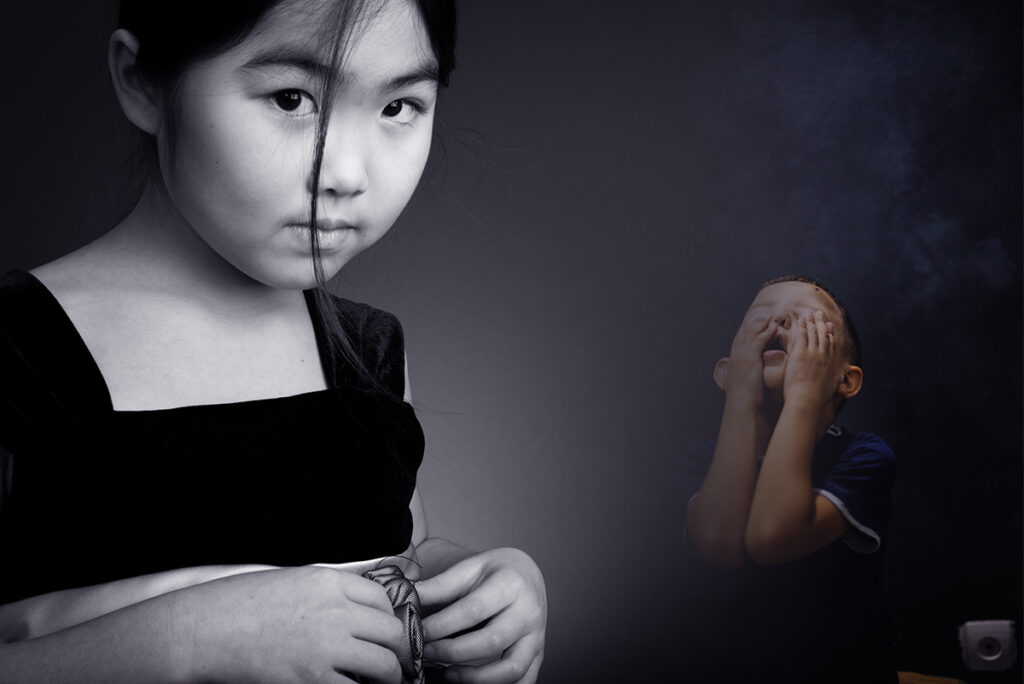The narcissistic child has omnipotent, controlling and tyrannical fantasies of controlling his mother (object), which are part of normal development but need to be transformed by parental figures, so adaptation of reality can be achieved through acceptance of psychic pain and suffering. Suppose the parent is emotionally arrested or unable to face and contain the pain of being different and separate from her child, or cannot challenge the child’s omnipotent fantasies of power and control, there will be a perpetuation of a fragile, insecure, narc personality. The parental figure, when absent, is emotionally unavailable or too strong to establish a straightforward process of separation. The oedipal translation is lacking and reversed, with the child ending up performing the functions of their parents, meeting their narcissistic needs and demands. The absence of a mother may lead to a deep sense of melancholia, a reaction to the loss of someone who is loved or has someone to love. There is a painful sense of dejection, a loss of interest in the outside world, or a preoccupation with activities that serve as a substitute for the lost object. The loss of capacity to find another object of love and the inhibition of all activities.
The libido is withdrawn into the ego, establishing identification with the abandoned object, whereby, when object cathexis is faced with obstacles and challenges, it may regress into narcissism. A narcissistic defence against future separation, denied via a mechanism of splitting and projective identification, where unwanted parts of oneself are split off and projected into the new object. The child simultaneously identifies with the object to the extent he feels that he is the object or the object is himself. If two people are supposed to be the same, there is no comparison, competition, envy, anger, or frustration, but rather a flat, so-called equality. We notice a reversal of projective identification, as it’s the mother, not the child, who projects into the child something unbearable, such as intense anxiety around separation. The child can’t contain the parental projections and is filled with overwhelming dread, pain and frustration. The mother becomes dependent on their children for their happiness and survival, creating severe identity and personality disturbances within her children. There’s an inability to bear intense feelings of shame along with an envious intolerance of loss. The impact of adolescent sexual development will bring particular disturbances for the narcissistically vulnerable. For the most fragile, a precarious sense of self held in rigid, idealised identifications, change brings disaster, fragmentation and breakdown. These new challenges affect one’s sense of identity and well-being, where narcissistic equilibrium is shattered into a world of chaos. Adolescence reawakens archaic and disturbing emotions and anxieties that require risk and produce failures, disappointments, and the experience of shame, alongside the discovery of realisable joy and mastery.

Sexuality
Confrontation with the exclusion from the parental sexual relationship (primal scene ) has to be bearable to the oedipal child, where the child’s self-esteem needs to have survived the encounter between adult reality and childhood ambition.it the parental relationship is too hosile, cruel or hatefully conceived, it is likely the hatred will permeate and pervert the adolescents relation to his body and that of the object. Brittle rigidities resulting from early parental loss, trauma, separation, being too frightening and intense feelings, too disturbing, sexuality too intrusive or violent and dirty will leave the adolescent poorly equipped to face up to the challenges of new opportunity and defensively estranged from sexual realities. Hated sexual feelings find expression and are simultaneously defended against in symptoms that aim to inhibit sexual desires that are not supported, permitted and incompatible with a fragile sense of worth and well-being.
The mature body, which heralds the loss of childhood and the advent of adult sexuality
The body, which has been interpreted to have betrayed the self, exposed the self to the abandonment of parental projections, lost forever some idealised, often purified sense of specialness, and became the object of attack. Behaviours such as anorexia, bulimia, self-inflicted injury, transsexuality and attempted suicide are strategies used by disturbed adolescents. The narcissistically compelled adolescent repudiates or believes they can magically control their development, driven by compulsion and perversion to stave off reality. All adolescents must endure the painful volatility and disappointments that come with taking on the risks of adulthood and finding no fulfilment in the possibility of individuality, sexual freedom, and difference—a cycle of narcissistic entrapment, a defensive withdrawal from the vicissitudes of intimacy and emotional life. All lively feelings and excitement are re-engaged in the primitive struggle with a maternal object with whom one remains hopelessly and helplessly stuck. Rigid control, lack of trust in boundaries, deep sense of danger and lack of faith in communicative symbolic processes. Narcissistic threats of engulfment and abandonment, at oedipal and pubertal milestones, keep one in limbo and unable to separate. One subverts emotional growth, provoking enforced closeness, where benign distance is needed, and the other lacks emotional refuel and nourishment when facing obstacles and narcissistic injury. This primitive attachment is the most shaming and anxiety-provoking pull within one’s emotional life in adulthood.
A daunting and potentially strangulating perfectionism needs to release its grip to start bearing ordinary expectations and a willingness to explore feelings, to tolerate doubt, acknowledge one’s confusion and ambivalence, and disclose some spontaneity. The transition into adolescence is facilitated by analysis and movement into adulthood, making it more bearable and tolerable, with a greater capacity to survive. The adolescent is in a constant process of adjustment and transition, contending with new sensations and fantasies, struggling to establish a new identity and find their place in the world. A grave uncertainty around the challenges and demands that lie ahead, and doubt about one’s adequacy, success and ability to flourish. Increased sexual anxiety and aggressive potential, with the loss of earlier equilibrium and containment, fear of overwhelm and failure in containing impulses and holding oneself together. There is a particular terror of limitlessness; there are no bounds to possibility, no end to what might happen or be found out. They feel curiously disconnected from all that has held them together in the past, and are confronted with all that is new, unfamiliar, and potentially threatening in the future. The process of individuation and separation brings the realisation that one must find and take responsibility for oneself and take ownership of one’s evolving body.

Grandiose and idealising Solution
Adolescents, in a sense, are often self-centred, self-preoccupied, and innocently arrogant; they are perceived as invincible, omnipotent, and self-sufficient. Equally absorbed with intense infatuation and devotion to other significant people, to the causes and activities that consume them and motivate them. They can falsely identify with the purity and perfection of others, leaving them vulnerable to manipulation and exploitation. Adolescence is inevitably complicated, bewildering, disconcerting, but equally energising, exciting, and very creative. The majority of adolescents make the most of it and successfully transition into adulthood, feeling free to risk defeat and frustration, able to tolerate their imperfections and those of others, ready to enjoy the excitement of life and the unknown. They can learn to have fun and know when to stop, and keep within the limits of their abilities.
Adolescents who are not secure within themself, have a fragile inner core and distorted self-beliefs, remain helpless and fearful of reality / they lack confidence and feel betrayed and let down by those whom they have idealised and shamed too early with their imperfections and limitations, developing deep narcissistic wounds and retreating into a world of grandiose fantasy. Either they duck their frustrations and complexities by retreating into the fantasy of their omnipotence, or they revere idols who symbolically represent clarity, perfection, and success. They build an inner world of certainty, safety and perfection, which they struggle to protect at all costs against incursion and reality. They effectively isolate themselves in self-created fortresses, a glass prison, and violently fend off the threats of encroachment.
Infantile interaction where the separated self and other are not recognised, respected and valued but are denied, or there is a seeking to control or attack the other, whose difference is felt as persecutory and uncaring. Unable to move with concern from one’s individual needs and wishes to a more mature understanding and acceptance of the others’ needs and wishes. Demonstrated by an inability to establish or sustain a meaningful intimate relationship or by producing a highly fused, undifferentiated one. The intimate couple come together and constructs the nature of their interaction based on mutual unconscious acceptance of each other’s projections, which creates a sense of recognition and attachment. The couple may be considered to be an enactment of intrapsychic conflicts and object relations in the daily living of interpersonal relationships.
Their lives become stuck, set and very lonely
Schizoid Mechanisms
The narcissistic nature of the schizoid personality derives from the infantile introjective and projective processes. The ego ideal is projected onto another person; this person becomes predominantly loved and admired because they contain the good part of the self. One of the consequences of projective identification is that the subject relates to the object not as a separate person with their characteristics, but as if they are relating to themselves. He will ignore aspects which do not fit the projection, or he may control, force, or persuade the object to enact the role required of him. The fantasy parts of the self and internal objects have been projected into the other, who is then identified as possessing these attributes. This narcissistic state is not necessarily a withdrawal into a psychic retreat of good admired internal objects, but also acts as an entry into destructive internal objects, an internal “mafia ” or “sabateur” whose job is to defeat any efforts of benign relating to part of the self. The more envious aspects of the self, the more omnipotent the self-sufficient attacks the dependent part of the self, which may wish to form new attachments and hence arouse the destructive envy of the narcissistic self. Discovery of the object gives rise to hate, a spoiling hostility at the realisation that the source of life and goodness lies outside. Unless the object complies with the dominating subject’s demands and wishes, there may be a volatile swing between idealisation of the compliant object and denigration of the independent/separate object.

Narcissistic symptoms of perfection, grandiosity and self-sufficiency, conjured up to combat the failure of separateness and differentiation, inferiority and low self-esteem. A lack of self-knowledge and awareness, characterised by a fragile sense of self, porous boundaries, and confusion between inner and outer perceptions. Children grow up as parental appendages or “dolls in a box,” with so little sense of their capacities or talents and reasonable entitlement to wishes, desires, and fulfilment that they can’t conceive of their life as their own. It may seem like a passive waiting game, expecting one day they will be fed, rescued, or played with by a new parent with unlimited resources and care. Others may anticipate a magical event, such as a new job or romance, where the clock of time will start ticking again. However, for some young people, parental needs eclipse awareness of their own, where unfulfilled accomplishments of parental expectations or preoccupation with parents’ hardship or emotional state take precedence, compensated by a grandiose determination ( active altruism) to rescue the victims, repair the damage and make good deficits irrespective of personal sacrifice. The individual may oscillate between passive waiting and active altruism, which become prominent features in their intimate and therapeutic relationships. The inertia of the first stance and sacrificial endurance in the second promote stuckness in life and an inability and unwillingness to move on.
What categories a narcissistic patient is their repair and sense of tftuilioy as they can’t internalise anything, nothing can be fed, digested or metabolised, they feel permanently empty. They are unable to use their own experience or reality; their isolated lives are developed to avoid anxiety by avoiding contact with other people and the accompanying frustration, pain and loss. One can feel the wholesale avoidance in the transferences, where the analyst has to carry the associated despair associated with the failure to make contact. The narcissist pushes ruthlessly in search of a primary object, a need or the revival of an archaic object rather than the instinctual investment of oedipal conflicts. They are looking for an ideal container and a perfect fit of understanding; they are highly intolerant of any frustration. Exhaustion is a standard component of early infant holding, but gradually, the infant’s satisfied needs lead to a decrease in their needs. On the other hand, the remaining task is to recognise that the patient is stuck at an impasse, where something in the analytic situation may need to change, where extreme unresolved issues may result in premature termination of treatment.

Perversions use auto erotic substitutes to cope with anxiety, eliminating feelings of helplessness by sexualising a dead, inanimate object, as well as destroying any knowledge of their need for love. The damaged or absent maternal object is replaced by a fantasy object that is felt to be entirely under the control of the subject. They project unwanted bad feelings into the redundant object, whilst creating a sense of potency through owning the source of their gratification. Aggression and anxiety caused by early fears of disintegration become eroticised and powerful rather than disintegrating into a terrifying descent into psychosis. If part of one’s body becomes fetishised or clothing used by the tranvestite, the accompanying unconscious fantasy is the source of gratification. The Pervert has identified a part of the self or invested an action or behaviour as the good object; for example, transvestite fantasy becomes the mother, and bad parts are projected outward into external objects. Getting into the object, dressing up as a woman, or in the transsexual case, becoming a woman, takes over all primary object qualities, enviously taking all the good, so the infant becomes the source of gratification, and the object being the source of it has to be robbed and devalued as the bad object. Enormous hostility against any awareness that life and goodness lie outside the self. If the narc were to become aware of his envy towards the object, it would be tantamount to recognising that its source of their gratification and not part of them. This would be unbearable, and acknowledging separateness and dependency has to be defended against at all costs.
The analyst must be ready for a taxing and exhausting experience with very meagre results
In severe forms of perversion, such as pedophilia or sexual murder, they need to destroy any goodness in the other to have total power over their victim; all the badness and impoverishment are transferred into the victim, and he is given relief through the projection of his psyche into the other. Defence against the death instinct, against a need for love, a primary envy as its source that lies at the heart of all perverse activity. Failure in the environment has been so great that there is a need to withdraw all sources of gratification from the external world and to give them to a part of the self.
Transexuality – a profound disturbance of psychological gender development well before puberty, with both the subjective sense of gender ( gender identity ) and gender specific behaviour (gender role behaviour) being discordant with anatomical gender. Feminine interest strikingly displayed, and an intense dislike of genitalia. Sexual orientation is homosexual, and behaviours developed are aimed at increasing the expression of the gender disorder. Commonly includes cross-dressing, with a sense of comfort, not sexual arousal. Painful search for help and usually for medical and surgical treatment aimed at reassignment as a woman. The level of interest in sexual activity is low.
Cooper, J. and Maxwell, N. (1995) Narcissistic Wounds: Clinical Perspectives (Exc Business And Economy (Whurr)























